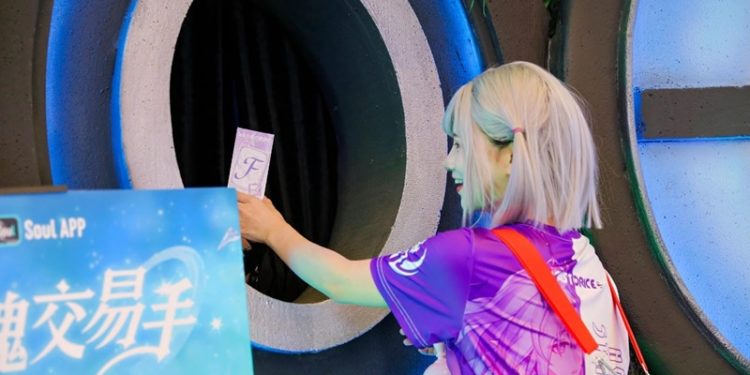Technology and creativity have never been diverging paths; rather, in today’s digital culture, they have always been closely intertwined forces that people use to express themselves and connect. At this year’s ChinaJoy Expo, Soul App, a popular social networking platform, highlighted the fusion of these two with complementary innovations, which included:
- Mobius 3rd edition, a part of the app’s digital collectible series designed to fulfill Gen Z’s need for avatar-based self-representation and storytelling.
- An end-to-end, full-duplex voice model designed to be the foundation for a new generation of intelligent, emotionally aware digital characters.
While each of these developments stood for a different dimension of social interaction, Soul App put them together and weaved them into its broader vision of making technology more personal, expressive, and human.
As far as Mobius was concerned, in its third edition, it created an even bigger buzz than it did three years back when the avatar set was newly introduced to the platform’s users.
Unlike earlier versions that focused primarily on customization, Mobius’ third iteration boasts cultural undertones and enhances emotional resonance. Zoomers are not into avatars that simply look different. Instead, they reach for avatars that capture their identities, moods, and creative flair. Mobius 3 delivers on these expectations, and then some more.
It brings to the table detailed facial expressions, fluid animations, and stylistic options that borrow from art, fashion, and gaming cultures. The design philosophy is not limited to aesthetics; it’s about giving users a richer visual language to express themselves in digital spaces. So, it was not surprising to see Soul App’s users swooping down on these digital collectibles as soon as the company debuted them at the ChinaJoy event.
Soul’s full-duplex voice model proved to be just as much of a crowd puller because it showcased the results of applying artificial intelligence to social interactions. What makes Soul’s model unique is the fact that it isn’t prone to rigid turn-taking. So, conversations with the model don’t sound scripted. The natural responses from the model are attributed to its ability to dynamically reflect tone, pacing, and context.
And it does not end there, Soul App’s emotionally intelligent full duplex model is just as good at understanding emotional cues that don’t come from the actual words spoken by the user. The model can gauge emotions and mood through interjections and voice tone with incredible accuracy. Simply put, the platform’s model pushes social AI toward a new level of authenticity; hence, characters based on it feel more like companions, collaborators, or guides rather than simple tools.
By combining avatars and voice-driven digital characters, Soul App has taken a dual-pronged approach to making digital interactions more immersive and emotionally engaging. With the Mobius Avatar series, Soul’s users get access to the visual identity they want to project and the story they want to tell, without compromising on their privacy.
As far as the voice model is concerned, it ensures that digital entities can interact in ways that feel emotionally authentic. The simultaneous launch of these two at ChinaJoy, is Soul App’s way of telling its users that they are being heard and that meeting their requirements remains a priority for the platform’s team. After all, Zoomers place value on both self-expression and emotional connection in digital communities, and that’s exactly what these innovations offer.
Having said that, at ChinaJoy, Soul App’s representatives also showed that dynamic avatars and an emotionally intelligent voice model can be brought together to infuse a strikingly human feel into human-machine interactions. To allow the attendees of ChinaJoy 2025 to enjoy their innovations firsthand, Soul’s team set up chat stations where people could interact with the full duplex model.
To enhance the overall experience for the users, Soul also gave their digital humans dynamic avatars, which essentially created a rich audio-visual ecosystem. One of the AI-generated chatbots was called Meng Zhishi, and he proved to be an expert conversationalist that everybody wanted to talk to.
One user decided to narrate a childhood story to the chatbot; Meng Zhishi used the precise interjections and fillers needed to make the user feel that the chatbot was keenly listening to what was being said. What’s more, Meng Zhishi’s tone and words changed dynamically in response to not just the conversation but also the tone of the user.
For instance, when the interaction was serious, he held on to a solemn tone and offered the reassurance that the user needed. But when the conversation turned funny, he responded with laughter, curiosity, and even his own blend of humor. The best part was that the avatar used by the chatbot responded to the change in tone and the gist of the conversation just the way a human would. So, from a playful wink to a knowing headshake, the avatar reflected exactly what Meng Zhishi wanted to convey.
In fact, the audio-visual synchrony at the core of Soul App’s model made users feel as if they were having a face-to-face conversation with another person. The effect was so remarkable that it could just as well have been a glimpse into a near future where digital personas will not just be static profiles but dynamic extensions of identity, capable of both visual creativity and meaningful conversation.
That said, with the presentation of these two innovations at ChinaJoy 2025, Soul has highlighted that it has a strategic understanding of Gen Z’s priorities. For Zoomers, digital platforms are not just utilities but canvases for creativity and stages for emotional exchange. By giving equal weight to both avatars and AI chatbots, Soul App has sent out a clear message that it intends to align its use of cutting-edge technology with the lived experiences of its primary audience.









































































